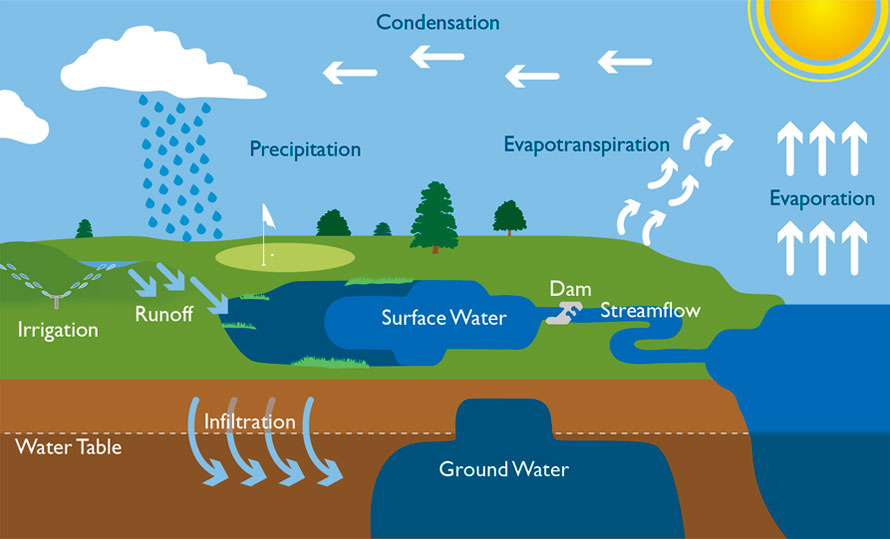The sun is the powerhouse for the hydrologic cycle, providing the energy for phase changes of water (evaporation and condensation) and for the storage and release of latent heat. Because water is an efficient solvent, all water-soluble elements follow this cycle at least partially. Thus, the hydrologic cycle is the integrating process for the fluxes of water, energy, and the chemical elements throughout the environment.
Water enters the hydrologic system as precipitation, primarily in the form of rainfall or snowmelt. It is then delivered to surface waters from runoff or infiltrates into the subsurface. Water can leave the system via stream flow or runoff, evaporation from open bodies of water, or evapotranspiration (evaporation from soil surfaces and transpiration from the soil by plants).
 The hydrologic cycle is the cyclic movement of water in its various phases through the atmosphere, to the Earth, over and through the land, to the ocean, and back to the atmosphere.
The hydrologic cycle is the cyclic movement of water in its various phases through the atmosphere, to the Earth, over and through the land, to the ocean, and back to the atmosphere.Groundwater Recharge
Water moves through the surface of the earth, eventually through the soil horizons to natural storage areas below the ground. Depending on subsurface rock formations and overall permeability, the filling of these storage areas or “recharge” can collect water from a few hundred square feet to a few square miles. Groundwater often provides the source of water for perennial stream flow at base flow conditions when there is no precipitation. It is critical to understand the basics of groundwater recharge, both in size and scope, to mitigate potential contamination.
Infiltration and Runoff
The amount of water that infiltrates into the ground from the total run off depends on a number of variables, including the intensity of precipitation or irrigation, soil infiltration capacity, site characteristics, antecedent soil moisture, and season.
Water that infiltrates into the soil either is stored within the soil profile or percolates downward toward groundwater, depending on the soil moisture conditions and soil structure. This soil water is then available for evapotranspiration. If the moisture-holding capacity of the soil is exceeded, the excess water percolates downward through the soil profile to groundwater. If the soils are at saturation, any additional precipitation does not infiltrate into the soil and becomes surface runoff instead. It is in this runoff that more soluble compounds applied to turf have the greatest potential to move off site.
Site characteristics including land use, land cover, soils, and topography also influence the amount of infiltration versus amount of runoff. Turf, forests, fields, and other vegetated areas slow down the flow of runoff, filter out sediments, and trap pollutants or break them down biologically. Conversely, hard impermeable surfaces such as buildings, roads, parking areas, and exposed bedrock prevent water from infiltrating into the ground. These hard impermeable surfaces, as well as bare soils, offer little resistance to reduce the velocity of runoff. Similarly, compacted soils and saturated soils retard the infiltration of water and therefore promote runoff. Lastly, steep slopes can increase the rate and amount of runoff.
The amount of runoff versus infiltration at any location also varies seasonally. During the winter, soils in New York are likely to be frozen and impermeable to water. Snowmelt, rain, and low evapotranspiration rates in the spring generate wet soil conditions and downward movement of water to groundwater. The potential for runoff is high because the near-saturated or partially frozen soils have low water infiltration capacities. During the summer, high rates of evaporation and plant water uptake may reduce soil water storage, leaving none to percolate downward. Summer rains only partially recharge the soil profile, and the soil’s moisture holding capacity is typically not exceeded. Except for high-intensity thunderstorms, runoff and erosion potentials are generally low during the summer. In the late fall, evapotranspiration rates decrease, and groundwater recharge occurs when the moisture-holding capacity of the soil is exceeded. Runoff and erosion potentials also increase during this period. However, in New York, runoff from turf most often occurs from wet soils and not from high rainfall intensity.
